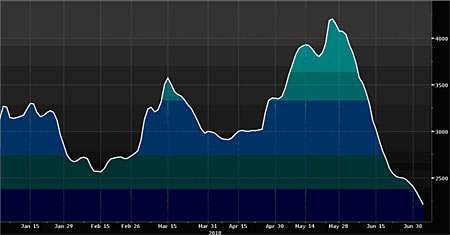
Stock markets have had a rough week or so. But that’s nothing compared to what’s been happening in a slightly more obscure market.
Yesterday, the Baltic Dry Index saw its 27th consecutive day of losses. That’s the longest continuous slump for five years.
The Baltic Dry measures the cost of shipping dry bulk goods – commodities such as iron ore and coal, for example. The index fell off a cliff during the credit crunch in 2008, as credit to finance global trade froze.
So what is the current sell-off telling us about the state of the global economy?
Should you worry about the shipping index sell off?
The Baltic Dry Index (BDI) has fallen almost in half since the end of May – as you can see on the chart below:
Wow. That looks nasty.
But let’s put it in perspective. This is nothing compared to the 95% drop the index saw before and during the financial crisis of 2008, as you can see below:
And by and large, analysts are saying that we don’t need to get too worried about this sell off either. Why not?
- The shares you’ll never want to sell
- Harvest profits from agricultural growth
The BDI measures the cost of shipping raw materials from one place to another. If the price of moving raw materials falls, then you’d assume that people are moving less stuff around the world. Presumably, that’s because demand for finished goods is also slowing down. Therefore, a drop in the BDI suggests that the global economy must be slowing down.
That’s all very logical. But it misses one point – the supply side. Because it measures the cost of shipping, the BDI might also be saying that there are simply too many ships. The BDI hit a record high in 2008, as demand for shipping rose far ahead of the supply of ships available.
So, as you’d expect, that meant that more ships were built. And fleets are still growing now, even although demand has fallen to more normal levels. More ships and static demand means shipping rates are falling.
As dry bulk researcher Derek Langston of Simpson Spence and Young told the Financial Times last month: “We still anticipate this year we will see a record year in terms of annual growth of trade. However, this is also accompanied by record growth in fleet supply.”
Special FREE report from MoneyWeek magazine: When will house prices bottom out – and how will you know?
- Why UK property prices are going to fall 50%
- When it will be time to get back in and buy up half price property
So everything’s just fine then? Well, we wouldn’t go that far. Melissa Kidd at Lombard Street Research is rather less sanguine about the fall in the index. Sure, “the quality of the BDI as a leading indicator has been disrupted by an oversupply of shipping.” But “the message of weaker global activity is supported by a range of other indicators.”
Chinese growth is slowing
One big factor in the fall has been a drop off in Chinese steel mill demand for iron ore. Iron ore shipments fell year-on-year in both April and May, according to Bloomberg. Iron ore is of course, a key ingredient in steel manufacturing.
But domestic steel prices in China have been falling for the past ten weeks. This is partly down to tighter monetary conditions. The construction industry is the major driver of steel demand. China’s attempts to curb the property market have hit steel consumption and therefore prices.
With iron ore prices remaining high, that’s pushed steel makers into losses. As Andreas Vergottis at Tufton Oceanic tells Bloomberg, “Profitability of Chinese steel mills is zero now, we think.”
The trouble, says Kidd, is that “China has been the world’s engine of growth for… commodities over the last 12-18 months. A cooling off in Chinese demand growth – prompted by ongoing monetary tightening – will impact heavily on global price developments” in the commodities market.
And China’s not the only one slowing down. “The JP Morgan Global Manufacturing PMI has fallen from a high of 60.9 in April to 57.0 in June.” The reading for new orders was particularly hard hit, falling from 60.3 to 55.5 over the same time. “While a PMI of over 50 points to economic expansion rather than contraction, the drop in the index components points to a slowing down in the pace of recovery.”
A turning point for the global recovery
What all this boils down to, says Kidd, is that “the global recovery has reached a turning point as the momentum provided by the inventory cycle wears off.” In other words, company restocking is now ending, and we’re waiting to see what sort of ‘real’ demand remains to pick up the slack once government stimulus is removed.
Just how bad things get remains to be seen. But even a slowing of demand doesn’t bode well for hard commodity prices in the second half of the year. We’ll be taking a closer look at what all this could mean for investors in the next issue of MoneyWeek, out on Friday (If you’re not already a subscriber, subscribe to MoneyWeek magazine.)
Our recommended article for today
Profit from more infrastructure stimulus
US states are looking at a $200bn hole in their budgets. The solution, believes David Fessler, will be more Federal assistance. Here, he tips two companies that should benefit from more infrastructure spending.